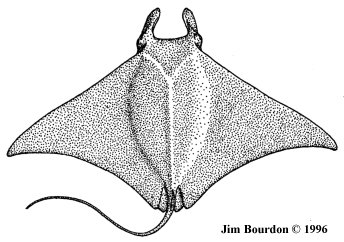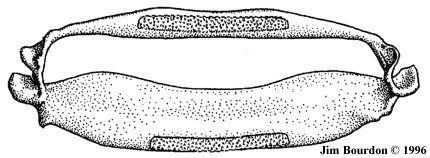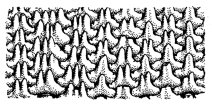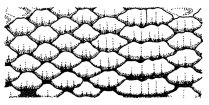| |

Like other members of the order Myliobatiformes,
the mobuloids have broad, well-developed pectoral fins, in certain species, a stinging spine,
and a whip-like tail. Unlike the others, the devil rays have large cephalic lobes which create
mobile peribuccal fins which direct food into the mouth. These are the largest batoids, reaching widths
of twenty feet and weights of 3,000 pounds, according to Bigelow & Schroeder.
These rays use their wing-like pectoral fins to work near surface waters, feeding on small
pelagic organisms -- schooling fish and planktonic crustaceans. They have no need for
the grinding dentition of other representatives of the order. This is reflected by the numerous
small, and often very poorly developed, teeth of recent species.
In Manta, and certain species of Mobula, i.e., M. japanica, the teeth are peg-like. In
Manta, however, teeth are only present in the lower jaw.
In general, the mobulids represent small to very large rays of subtropical and tropical waters.
They are planktonic feeders that often school. Although single-cusped teeth are usually
bilobate, they have polyaulacorhizous roots which are most evident in those teeth which
are mesio-distally elongated.
 |
| Fig.1 Mobula hypostoma Lesser devil ray |
Western Atlantic Devil Rays
The Bigelow & Schroeder (1948) inventory of rays from the western North Atlantic included:
Mobula hypostoma RAFINESQUE, 1810 , possibly the eastern
Atlantic species M. mobular (BONNATERRE, 1788),
Ceratobatis robertsii BOULENGER, 1897, and
Manta birostris (DONNDORFF, 1798).
Notarbartolo di Sciara (1987) did an extensive revisionary study of the genus Mobula
and concluded that there were nine extant species. He found teeth to be quite
variable in the genus, and placed greater significance in soft tissue morphological
delimiters, such as the branchial filter plates and body pore placement, none of which
are likely to appear in the fossil record. Candidates for Lee Creek include those listed
by Bigelow & Schroeder (C. robertsii deemed synonymous with M. hypostoma) and
several species that are known from the eastern Atlantic: M. rochebrunei
(VAILLANT, 1879), M. thurstoni (LLOYD, 1908),
M. kuhlii (VALENCIENNES
in Müller & Henle, 1841), and M. tarapacana (PHILIPPI, 1892).
Unlike most studies of living batoids employed in this research, this work provides excellent detail
of tooth morphology.
Mobula hypostoma - (BANCROFT, 1931) Lesser devil ray
This is a small (up to four feet in width) ray of subtropical and tropical coastal waters of the
western Atlantic, from Argentina to North Carolina, including the Caribbean and Gulf of Mexico.
Notarbartolo di Sciara describes it as having no caudal spine and smooth-crowned imbricated teeth
which display strong sexual dimorphism. He points out that the male teeth generally have two
cusps, and that single and triple cusped teeth are less frequent.
The female dentition is made up of low-crowned teeth (fig. 4). The illustrated partial dentition
(USNM #232,731) has 53 upper and 48 lower files. The upper teeth range from 1.5 to 3.0 mm in width,
larger in the mesial and distal positions. The lower teeth are more widely separated, unlike
the closely packed upper teeth.
The male dentition is made up of teeth with elongated cusps (figure 3). The specimen used for the
illustration (fig. 2, USNM #232,732%) had 56 upper files, which measure 62 mm wide by 7 mm deep.
The teeth range from 1.5 to 3.0 mm in width, with the larger teeth usually in mesial and distal positions.

Fig. 2 M. hypostoma
USNM #232,732, male dentition 16.4 cm in width
|


H. hypostoma upper medial files, USNM #232,731 & 2,
Labial at bottom
Fig. 3 (left) Male. 1st LH, symph, 1 thru 7 RH files;
Illustrated width = 10.0 mm.
Fig. 4 (right) Female. 1 thru 6 LH, symph, 1st RH;
Illustrated width = 9.5 mm. |
|